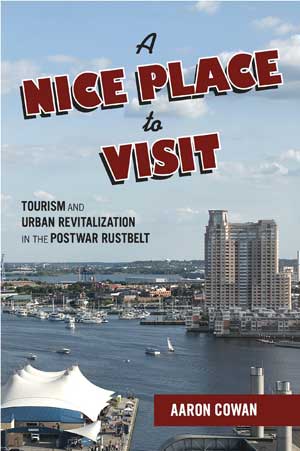
A Nice Place to Visit explores how four American cities – Baltimore, Cincinnati, Pittsburgh, and St. Louis – coped with the problems of economic decline after World War II, and how and why tourism gradually gained a vital position in their postindustrial economies. The book is organized into case studies of each city, paired with a particular type of tourist development. So, for example, in Cincinnati, I look at the transformation of downtown hotels in the postwar decades, or in Pittsburgh, the story of professional sports and stadium development. In each case, I focus on the story in one city to illustrate broader consequences of tourist development in these four cities, and postwar urban America generally.
The urban tourist industry began with the growth of business conventions in the post-World War II period. Beginning in the 1950s and accelerating thereafter, cities rushed to build massive convention centers, new convention hotels, and develop aggressive marketing campaigns to recruit trade and business meetings. For the first time, city governments played a direct role in facilitating, and often subsidizing, construction of this infrastructure. Even in the 1950s and early ‘60s, the loss of manufacturing jobs and residents left city leaders increasingly desperate to spur a new economic base. St. Louis mayor A.J. Cervantes spoke in the 1960s of tourism as one business “that cannot move to the suburbs.”
Other types of tourist development sought to create attractions – for example, St. Louis’ Gateway Arch, or Baltimore’s Inner Harbor – that would both draw leisure travelers and provide a easily-marketable “front door” that could reshape the perception of the city in public media. Again, public subsidy and public-private partnerships played a key role in these sites. By the 1980s, cities across the nation pursued new tourism trophies – festival marketplaces, aquariums, “experiential” museums, casinos – in a seemingly endless competition to capture the tourist dollar.
These developments had varying degrees of success, but even the most popular failed to fully address the problems of poverty, underemployment, crime, and suburban flight. And tourist-oriented construction often absorbed increasing percentages of city’s precious public resources, while remaking major portions of the city’s downtown to serve visitors, not locals.
Historians, geographers and cultural scholars have written a great deal about tourism in places like Las Vegas, New Orleans, and major resort areas. This book reminds us that the rise of the tourism industry also reshaped less exotic locales, in both positive and negative ways.
As a graduate student at the University of Cincinnati, I recall walking around the city’s downtown at the time and thinking how much of the central city around me – the massive convention center, a half-dozen chain hotels, the restaurants locals never patronized – was intended for people who didn’t live there. This seemed strange somehow, but I also knew Cincinnati was not unique in this regard. This got me thinking about the historical transition of downtowns away from being the hub of local life, as they had been in the early-mid twentieth century, to these places dominated by office buildings and tourist developments.
So the big questions the book addresses are, how and why did this happen? And what is lost when so much of a city is remade to appeal to visitors? Is it possible to create urban spaces that attract visitors but also have meaning and significance to local residents?
Another big theme of the book is the tension between a city’s image and reality. Today we see the “branding” of cities, carefully cultivated through multi-million dollar advertising campaigns that attempt to define a place by the consumer choices available to visitors. This can have a sort of Potemkin village effect, in which tourist experiences come to represent a city in the media and public perception, deliberately obscuring problems that might be unappealing to visitors.
For example, you mention Baltimore, and someone might say, “Oh, I went there for a convention once – what a beautiful, vibrant city.” And then you find out they never really left the tourist-friendly Inner Harbor. So they didn’t see West Baltimore. They didn’t visit Cherry Hill. They didn’t see the hyper-segregation, the abandoned housing, and the underfunded schools.
And of course Baltimore is beautiful and vibrant in lots of ways, and not just in the Inner Harbor. But it is also a city still reeling from the consequences of racism, the war on drugs, and deindustrialization. That doesn’t show up in the tourist brochures. I think about this every time I read a travel story in The New York Times or other national media touting how Detroit or Cleveland is now “reborn” because they have a microbrewery district, hip new art museum, or fashionable boutique hotels. There’s nothing wrong with those things, of course, but I think the historical narrative of A Nice Place to Visit also raises important questions about the degree to which these attention-grabbing developments make a substantial improvement in the lives of most city residents. I have significant doubts that they do.
At the same time, the book’s not a jeremiad against urban tourism – I try to push back against a lot of the scholarly critique of tourist development, much of which seems to perceive tourism as inherently exploitative and “inauthentic.” Understanding the historical context, in which these decisions were made, when options for renewing the city were limited by major political and economic constraints, gives us a much more complex picture, as well as some degree of empathy for decisionmakers. In the end, the mixed record of postwar urban tourist development reveals not a straightforward narrative of a “devil’s bargain.” Rather, the story of Rustbelt tourism reveals just how complex and difficult a project it is to truly revive an American city.
Chapter 3, which explores the campaign in the 1970s to build a convention center in downtown St. Louis, is probably the chapter that really cuts to the heart of the conflicts taking place in these cities. City leadership proposed a $21 million public bond issue to build the center, at the moment that the city’s economy was in free fall, and suburban migration was rapidly depleting the residential tax base.
The proposed convention center site was also controversial – it sat right on the northern edge of downtown, adjacent to the city’s Northside, a struggling working-class, largely African American, neighborhood. Standing at the site, one could see underfunded public housing projects, potholed city streets, and blocks of dilapidated housing owned by absentee slumlords. Working-class political activists, especially in the Black community, mounted a strident campaign against the publicly financed convention center, but ultimately lost their battle. The Northside continued to decline, and the convention center continued to absorb millions in public subsidy over the following decades.
The St. Louis story is a stark depiction of the shifting priorities of urban leadership in the postwar era, when large flashy development projects became more important than things like housing, schools, and basic governmental services. Cities began to believe they could build their way out of economic decline, and it had real consequences for people’s lives.
On a somewhat brighter note, Chapter 5, on Baltimore’s Inner Harbor, is another favorite because there I relate fantastic examples of local residents refusing to cede tourist spots over to out-of-towners completely. To give just one example: in the city mayor’s papers, I found numerous letters from suburban white visitors concerned about groups of black teenagers gathering on the promenade, playing loud music, and dancing.
I finally figured out that Harborplace (the “festival marketplace” built on the Inner Harbor) had become, in the early 1980s, one of the key spots for the city’s early hip-hop scene. It provided a central meeting place for kids from all around the city, and a built-in audience for rappers and dancers. So this demonstrates one of the ways in which urban residents exploited the opportunities provided by Harborplace to create and nurture a singular culture not dictated by the official power structures that defined their lives in so many other ways. The function of tourist sites, like all urban spaces, is never simply defined by the elites – it is always contested and layered with different meanings.
Tourism is one of the largest and fastest-growing industries in the world, and it has an important role to play in the postindustrial American city. Cities should be entertaining and attractive places to visit. Tourism is obviously a major industry that cities cannot afford to neglect entirely. The rise of the tourist economy created a new economic function for downtowns, and did bring a new kind of vitality to American cities. The historical narrative in A Nice Place to Visit, however, suggests that an overzealous dedication to enhancing this role at the expense of the greater urban community leads to discord, resentment, and the remaking of central cities to serve the interests and tastes of outsiders rather than locals.
Tourism continues to be an attractive lure to cities that see it as a panacea for economic ills. Cities continue to offer tax abatements and millions in public subsidy to casino developers and professional sports franchises, even as budgets for public schools and municipal services are cut to the bone.
I would like to believe that the stories in my book would give governmental and business leaders pause; not to reject tourism altogether, but to ask questions like: How can we develop a successful urban tourist economy that doesn’t alienate a city’s residents? How do we make sure the benefits of tourist development are equitable and that tourism truly contributes to the greater good of a community, not just hotel chains or global corporations?
I would hope that those with the power to shape the urban political economy would thoughtfully consider ways to insure that our cities are both “nice places to visit” and also good, just communities, in which to live.


Aaron Cowan is Associate Professor of History at Slippery Rock University in western Pennsylvania. His research and teaching interests include urban, environmental and public history. He is also founder and co-director of Slippery Rock University’s Stone House Center for Public Humanities, an initiative that seeks to expand public appreciation of the humanities and their relevance to contemporary life.